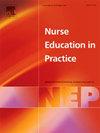Randomized control trial in nursing education: A bibliometric analysis and visualization
IF 3.3
3区 医学
Q1 NURSING
引用次数: 0
Abstract
Aim
The aim of this study was to examine randomized controlled trials in nursing education using bibliometric analysis.
Methods
Descriptive and bibliometric analyses were used. Web of Science database was used to determine the most frequently cited studies of nursing education randomised controlled trials, the most influential journals in this field, trends and trends of studies. Bibliometric analysis and visualisation were performed using VOSviewer and Bibliometrix Package in R software.
Results
In the study, a total of 141 publications were published in 29 different sources between 2007 and 2025. The most influential journal where the studies were published was Nurse Education Today (n = 53). In the studies, 405 author keywords belonging to 623 authors were found. The most frequently used author keywords were ‘simulation (n = 18)’, ‘knowledge (n = 8)’, ‘simulation training (n = 8)’, ‘learning (n = 7)’ and ‘anxiety (n = 6)’. It was found that the most frequently used trend topics in the early years were ‘attitudes’, while in recent years, trend topics such as ‘simulation’, ‘knowledge’ and ‘skills’ have become popular.
Conclusion
The number of randomized controlled trials in nursing education has been on the rise in recent years. The findings of this study will contribute to the advancement of nursing education literature and inform future scientific studies by addressing existing gaps in knowledge in this field.
护理教育的随机对照试验:文献计量分析和可视化
目的本研究的目的是运用文献计量学分析对护理教育中的随机对照试验进行检验。方法采用描述性分析和文献计量学分析。使用Web of Science数据库确定了护理教育随机对照试验中最常被引用的研究,该领域最具影响力的期刊,研究趋势和趋势。使用R软件中的VOSviewer和Bibliometrix Package进行文献计量分析和可视化。结果2007年至2025年间,共有141篇论文在29个不同的来源发表。发表这些研究的最有影响力的期刊是《今日护士教育》(n = 53)。共检索到623位作者的405个作者关键词。最常用的关键词是“模拟(n = 18)”,“知识(n = 8)”、“模拟训练(n = 8)”,“学习(n = 7)”和“焦虑(n = 6)”。研究发现,早年最常用的趋势话题是“态度”,而近年来,“模拟”、“知识”和“技能”等趋势话题变得流行起来。结论近年来护理教育的随机对照试验数量呈上升趋势。本研究的结果将有助于护理教育文献的发展,并通过解决该领域现有的知识空白,为未来的科学研究提供信息。
本文章由计算机程序翻译,如有差异,请以英文原文为准。
求助全文
约1分钟内获得全文
求助全文
来源期刊

Nurse Education in Practice
NURSING-
CiteScore
5.40
自引率
9.40%
发文量
180
审稿时长
51 days
期刊介绍:
Nurse Education in Practice enables lecturers and practitioners to both share and disseminate evidence that demonstrates the actual practice of education as it is experienced in the realities of their respective work environments. It is supportive of new authors and will be at the forefront in publishing individual and collaborative papers that demonstrate the link between education and practice.
 求助内容:
求助内容: 应助结果提醒方式:
应助结果提醒方式:


